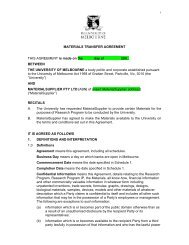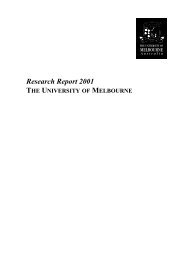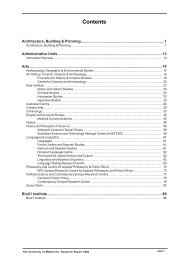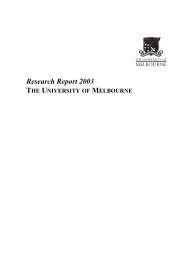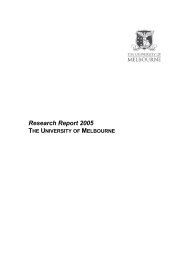Ten Top Tips for Animal Ethics Application Success - Melbourne ...
Ten Top Tips for Animal Ethics Application Success - Melbourne ...
Ten Top Tips for Animal Ethics Application Success - Melbourne ...
You also want an ePaper? Increase the reach of your titles
YUMPU automatically turns print PDFs into web optimized ePapers that Google loves.
6. Assembling the<br />
right team<br />
During the initial planning stage the<br />
project supervisor must assemble a<br />
team that is competent to per<strong>for</strong>m every<br />
task and procedure associated with live<br />
animal work. The AEC needs to know<br />
who is responsible <strong>for</strong> ALL the work<br />
with animals, including husbandry<br />
and monitoring. Specific tasks need<br />
allocating to named individuals who in<br />
turn have documented skills to carry out<br />
these tasks. For each person named on<br />
an application the following details must<br />
be included:<br />
• What they will do to the animals.<br />
• What experience they have of<br />
procedure(s) they will carry out on<br />
live animals, and in the specific<br />
techniques described in the project.<br />
• What training they will need, and how<br />
such training will be provided.<br />
Be<strong>for</strong>e the animal ethics application is<br />
lodged with the AEC it is vital that all<br />
members of the project team are aware<br />
of the details of the project and have<br />
agreed to their allocated responsibilities<br />
via signed approval.<br />
7. Piloting and/<br />
or staging the<br />
project?<br />
Where novel techniques or experimental<br />
designs are proposed, and it is not clear<br />
what initial results will show (or whether<br />
adverse reactions may occur), AECs<br />
are typically cautious about allowing<br />
full animal numbers to be engaged in<br />
a project. In these circumstances, it<br />
is advisable to build an exploratory<br />
pilot into the project, or to apply<br />
<strong>for</strong> a stand-alone preliminary pilot<br />
study. This will confirm (or otherwise)<br />
the efficacy of the animal model/<br />
experimental design, and establish<br />
details such as humane endpoints, dose<br />
rates/timings, or bias caused by gender/<br />
age issues, ahead of the full-blown<br />
project.<br />
Similar approaches may be built into<br />
a staged experimental design. For<br />
instance, doses can be administered<br />
and assessed sequentially (i.e. from<br />
lowest to highest) to minimise use of<br />
animals if one of the lower doses proves<br />
effective.<br />
Photo by Dr Steve Swearer, Department of Zoology<br />
5







